255b9726316ba1058dd39768bb59af44.ppt
- Количество слайдов: 85

“Transforming Digital Library, Digital Government, and E-Commerce: A Knowledge Management Perspective” Hsinchun Chen, Ph. D. Mc. Clelland Professor of MIS University of Arizona 美國亞歷桑那大學, 陳炘鈞 博士 • • • PI, NSF DLI-1, DLI-2, NSDL; Director, Artificial Intelligence Lab PI, NSF Digital Government Program, ITR Director, Hoffman E-Commerce Lab; PI, SAP, HP research programs; Founder, Knowledge Computing Corp.

Digital Library: Overview

Introduction • The Internet is changing the way we live and do business. • Opportunities for libraries, governments, and businesses: to better deliver its contents and services and interact with its many constituents – citizens, patrons, businesses, and other government partners. • Exciting and innovative transformation could occur with the new technologies and practices: in addition to providing information, communication, and transaction services. • Review and comparison: but with more focus on digital library + some examples/case studies

Digital Library: Characteristics • No need to leave the home or office: information now readily available on-line via digital gateways furnished by a wide variety of information providers. • Information is multimedia: electronically available in a wide variety of formats, many of which are large, complex (i. e. , video and audio), and often integrated. continue

Digital Library: Characteristics (continued) • Interface to the Web has evolved from browsing to searching: but the commercial technology has remained largely unchanged from its roots in the 1960 s. New research presents new opportunities. • Social impact matters as much as technological advancement: DL projects need to examine the broad social, economic, legal, ethical, and cross-cultural contexts and impacts.

DLI-1, DLI-2, NSDL, JCDL, ECDL, and ICADL: Towards Building A Global Digital Library • NSF Digital Library Initiative Phase 1 (DLI-1), 1994 -1998 • NSF CISE/IIS Special Program, $24 M, NSF, DARPA, NASA funding; Six projects: Stanford, Berkeley, UCSB, Michigan, CMU, UIUC. • Technology focus, new and rich library content; Bi-annual site visits and project meetings. Special activities: IEEE Computer, CACM, JASIS special issues, and many books and book chapters. continue

DLI-1, DLI-2, NSDL, JCDL, ECDL, and ICADL: Towards Building A Global Digital Library (continued) • NSF Digital Library Initiative Phase 2 (DLI-2), 1998 -2003 • NSF CISE/IIS Special Program, $60 M, 1998 -; NSF, DARPA, NLM, Lo. C, NASA, NEH; 20+ projects: Stanford, Berkeley, UCSB, CMU, Arizona, and many others. • Strong focus on integration of technologies, contents, and service. Annual NSF all-PI meeting with JCDL. continue

DLI-1, DLI-2, NSDL, JCDL, ECDL, and ICADL: Towards Building A Global Digital Library (continued) • National Science Digital Library (NSDL), 2000 • NSF CISE/IIS Special Program, $45 M, 60+ projects: Strong education focus in many different application domains. • Annual NSF all-PI meeting in DC. Core Integration effort: Cornell (Open Archive Initiative), UCAR, U. Mass. , etc. • Joint Conference on Digital Libraries (JCDL), 1996 • ACM DL Conferences and IEEE DL Conferences, 1996 -2000. • JCDL 2001, Virginia, E. Fox; JCDL 2002, Oregon, G. Marchionini; NSF DLI-2 all-PI meeting held after JCDL. continue

DLI-1, DLI-2, NSDL, JCDL, ECDL, and ICADL: Towards Building A Global Digital Library (continued) • European Conference on Digital Libraries (ECDL), 1997 • Many working group meetings held in different DL sub-areas. • International Conference of Asian Digital Libraries (ICADL), 1998 • ICADL 1998, Hong Kong, J. Yen; ICADL 1999, Taipei, Taiwan, Hsueh-hua Chen; ICADL 2000, Seoul, Korea, Key-Sun Choi; ICADL 2001, Bangalore, India, Shalini R. Urs (600 people); ICADL 2002, Singapore, S. Foo and E. Lim (450 people); ICADL 2003, KL, Malaysia, Baba • Local content, cultural heritage, education and deployment, multilingual retrieval, other new technologies; Many other national programs: China, India, Russia, Japan, etc.

Digital Library: Challenges • Cultural and historical heritage: Many digital library and museum collections contain artifacts that are fragile, precious, and of historical significance. • Heterogeneity of content and media types: Digital library collections have the widest range of content and media types, ranging from 3 D chemical structures to tornado simulation models, from the statue of David to paintings of Van Gogh. continue

Digital Library: Challenges (continued) • Intellectual property issues: Unlike digital government or e-commerce applications that often derive their own content, digital libraries provide content management and retrieval services to many different information creators. • Cost and sustainability issues: Many patrons often would like library services to be “free” or at least extremely affordable. • Universal access and international collaboration: Digital library content is often of interest to not just people in one region, but possibly all over the world.

Digital Government and E-Commerce: Overview

Digital Government: Characteristics • Multi-faceted roles of Federal Government: Government as a major user of information technologies, a collector and maintainer of very large data sets, and a provider of critical and often unique information services to individuals, states, businesses, and other customers. • Potential for nearly ubiquitous access: to government information services by citizen/customers • Re-inventing the government: Enhancements derived from new information technology-based services can be expected to contribute to reinvented and economical government services, and more productive government employees.

Digital Government: US Government Goes Electronic • 1986 Brooks Act amended: reducing government costs through volume buying, including IT purchases. • 1996 Information Technology Management Reform Act: Establishing the CIO position to manage IT resources. • 1998 Web. Gov portal: announced in August 1998, failed and replaced by First. Gov portal after technology donation from Inktomi. • 2000 Federal Rehabilitation Act: Requiring all IT products be accessible to the disabled. continue

Digital Government: US Government Goes Electronic (continued) • 2000 First. Gov portal unveiled in June 2000. • 2001 National Security Telecommunications and Information Systems Security Policy No. 11: Mandating off-the-shelf software used in defense be evaluated by an approved third party (NSA). • 2001 Health Insurance Portability and Accountability Act (HIPPA): Requiring health care information in compliance with privacy regulations • 2002 E-Government Act: Funding additional e-government initiatives and creating Office of Electronic Government.

Digital Government: Research Programs • NSF DG Program, 1998 - : areas such as: law enforcement information sharing, citizen access to government statistical data, and comprehensive emergency management; Digital Government Research Center (DGRC) and annual NSF-sponsored Digital Government Conference (DG. O) • EU: areas such as: online public service for information content; politics, e-democracy, e-voting; transactions, security, and digital signatures for e-government. • Other regions: Many ongoing e-government (G 2 C) initiatives have also emerged in Asia and Pan-Pacific countries such as: China, Singapore, Japan, Korea, India, New Zealand, Australia, etc. E-government projects in Latin American countries have also been reported.

Digital Government: Challenges • E-commerce is not at the heart of e-government: The core task of government is governance, the job of regulating society, not marketing and sales. • Organizational and cultural inertia: Most government entities are not known for their efficiency or willingness to adopt changes. • Government laws and legal regulations: Although well-intended, such laws and regulations often inhibit innovation or thinking “out-of-the-box. ”

Digital Government: Challenges (continued) • Security and privacy issues: Government-provided services have an extra burden of guaranteeing security and privacy for citizens. • Disparate and out-dated information infrastructure and systems: Many government departments at all levels often face budget shortfalls for years. • Lack of IT funding and personnel: Some government units (local, state, and federal) are affluent, but most are not. IT spending often is not a priority.

E-Commerce: Characteristics • Business/commercial initiatives: From Fortune 500 companies to Internet start-ups, from self-funded dotcoms to ventures funded by influential VCs (unlike digital library or digital government research). • Quick evolution and extensive coverage in many magazines and newspapers: Business Process Re-Engineering (BPR), Total Quality Management (TQM), Enterprise Resource Planning (ERP), Supply-Chain Management (SCM), Knowledge Management (KM), Customer Relation Management (CRM), etc.

E-Commerce: Challenges • Internet time or library/government time: In a competitive business environment, “Internet time” often demands a business to act on its instinct and to take risks. • Build it, but will they come: With the intense business pressure to perform and significant injection of funding (at least before the Internet bubble burst), many companies invest significantly in major Internet-based e-commerce infrastructure and product initiatives. • True innovations or marketing hypes: With the fast moving and sometimes impulsive business behaviors, marketing hypes are often disguised as true innovations.

The Information-Communication. Transaction-Transformation (ICTT) Continuum: The Path to Innovation • Information: content (e-library) • Communication: interaction (e-government) • Transaction: process and rule (e-commerce) • Transformation: innovation (all)

ICTT: Information • Definition: Library, government or business “information” is created, categorized, and indexed and delivered to its target audiences through the Internet. • Core competency of digital library research and services: metadata generation, data creation and management, content management, interoperability, system interfaces, etc. • Many early G 2 C (government-to-citizen), G 2 B (government-tobusiness), and B 2 C services deliver information only: governments and business portals act as information (about regulations and products) providers.

ICTT: Communication • Definition: E-services support two-way “communication, ” whereby customers or citizens can communicate their needs or requests through web forms, email, or other Internet media. • Core function for e-government: by providing effective communication channels to citizens. • Many early B 2 C, G 2 C and G 2 B applications quickly evolved into such communication services: by adding simple web-based groupware functionalities such as web forms, email, bulletin boards, chat rooms, etc. • Computer-Supported Collaborative Systems (or groupware) and recommender systems: can significantly improve communication services for all digital library, digital government, and e-commerce applications.

ICTT: Transaction • Definition: Citizens and businesses are supported in conducting “transactions. ” • Transaction is the essence of e-commerce: “You are not successful unless they buy. ” Many businesses support transactions among their suppliers (B 2 B) or customers (B 2 C) through ERP, SCM, and CRM systems. • Digital government could support “citizen transactions: ” such as income tax filing & returns, municipal service requests and tracking, business license applications and payments, etc. • Significant adaptation needed for e-government and digital library: to be cost-effective for non-commercial applications. (Most governments and libraries cannot afford SAP R 3!)

ICTT Continuum: Transformation • Definition: There is an opportunity for “transformation” for libraries, government agencies, and businesses through new technologies. • Digital libraries: Traditional libraries need to re-examine their content management and service delivery assumptions and practices. • E-Commerce: Business consulting professionals are creating new methodology and best practices to take advantage of the new business opportunities. • E-government: New information technologies and innovative processes could significantly enhance many facets of the governments, e. g. , epolitics and e-voting, law enforcement and litigation support, etc.

Knowledge Management: Overview

Unit of Analysis • Data: 1980 s – Factual – Structured, numeric Oracle, Sybase, DB 2 • Information: 1990 s – Factual Yahoo!, Excalibur, – Unstructured, textual Verity, Documentum • Knowledge: 2000 s – Inferential, sensemaking, decision making – Multimedia ? ? ?

Data, Information and Knowledge: • According to Alter (1996), Tobin (1996), and Beckman (1999): – Data: Facts, images, or sounds (+interpretation+meaning =) – Information: Formatted, filtered, and summarized data (+action+application =) – Knowledge: Instincts, ideas, rules, and procedures that guide actions and decisions

Application and Societal Relevance : • Ontologies, hierarchies, and subject headings • Knowledge management systems and practices: knowledge maps • Digital libraries, search engines, web mining, text mining, data mining, CRM, e. Commerce • Semantic web, multilingual web, multimedia web, and wireless web

2010 The Third Wave of Net Evolution ARPANET Function Internet Server Access “Semantic. Web” Info Access Knowledge Access 1995 Unit Server File/Homepage Concepts 1975 Example Email 2000 WWW: “World Wide Wait” Concept Protocols 1985 1965 Company IBM Microsoft/Netscape ? ? ?

Knowledge Management Definition “The system and managerial approach to collecting, processing, and organizing enterprise-specific knowledge assets for business functions and decision making. ”

Knowledge Management Challenges • “… making high-value corporate information and knowledge easily available to support decision making at the lowest, broadest possible levels …” – Personnel Turn-over – Organizational Resistance – Manual Top-down Knowledge Creation – Information Overload

Knowledge Management Landscape • Research Community – NSF / DARPA / NASA, Digital Library Initiative I & II, NSDL ($120 M) – NSF, Digital Government Initiative ($60 M) – NSF, Knowledge Networking Initiative ($50 M) – NSF, Information Technology Research ($300 M) • Business Community – Intellectual Capital, Corporate Memory, – Knowledge Chain, Competitive Intelligence

Knowledge Management Foundations • Enabling Technologies: – Information Retrieval (Excalibur, Verity, Oracle Context) – Electronic Document Management (Documentum, PC DOCS) – Internet/Intranet (Yahoo!, Excite) – Groupware (Lotus Notes, MS Exchange, Ventana) • Consulting and System Integration: – Best practices, human resources, organizational development, performance metrics, methodology, framework, ontology (Delphi, E&Y, Arthur Andersen, AMS, KPMG)

Knowledge Management Perspectives: • Process perspective (management and behavior): consulting practices, methodology, best practices, e-learning, culture/reward, existing IT new information, old IT, new but manual process • Information perspective (information and library sciences): content management, manual ontologies new information, manual process • Knowledge Computing perspective (text mining, artificial intelligence): automated knowledge extraction, thesauri, knowledge maps new IT, new knowledge, automated process

KM Perspectives Cultural Human Resources Databases e. Portals Tech Foundation Email Best Practices Learning / Education Consulting Methodology Infrastructure Content/Info Content Mgmt Structure KMS Ontology Analysis Notes User Modeling Search Engine Text Mining Data Mining

• Dataware Technologies (1) Identify the Business Problem (2) Prepare for Change (3) Create a KM Team (4) Perform the Knowledge Audit and Analysis (5) Define the Key Features of the Solution (6) Implement the Building Blocks for KM (7) Link Knowledge to People

• Anderson Consulting (1) Acquire (2) Create (3) Synthesize (4) Share (5) Use to Achieve Organizational Goals (6) Environment Conducive to Knowledge Sharing

• Ernst & Young (1) Knowledge Generation (2) Knowledge Representation (3) Knowledge Codification (4) Knowledge Application

KM Architecture (Source: Gartner. Group) Web UI Web Browser Knowledge Maps Knowledge Retrieval Conceptual Enterprise Knowledge Architecture Physical KR Functions Text and Database Drivers Application Index Text Indexes Database Indexes Applications “Workgroup” Applications Databases Intranet and Extranet Distributed Object Models Network Services Platform Services

Knowledge Retrieval Level (Source: Gartner. Group) KR Functions Concept “Yellow Pages” Semantic • Clustering — categorization “table of contents” • Semantic Networks “index” • Dictionaries • Thesauri • Linguistic analysis • Data extraction Collaboration Retrieved Knowledge • Collaborative filters • Communities • Trusted advisor • Expert identification Value “Recommendation”

Knowledge Retrieval Vendor Direction (Source: Gartner. Group) Market Target Newbies: • grape. VINE • Sovereign Hill • Compass. Ware • Intraspect • Knowledge. X • Wise. Wire • Lycos • Autonomy • Perspecta Technology Innovation * Not yet marketed Knowledge Retrieval New. Bies IR Leaders: • Verity • Fulcrum • Excalibur • Dataware Niche Players: • IDI • Oracle • Open Text Microsoft • Folio • IBM • In. Text Niche Players • PCDOCS • Documentum Content Experience Netscape* Lotus

KM Software Vendors Challengers Leaders Lotus * Microsoft * Ability to Netscape * Execute Documentum* * IBM PCDOCS/* Fulcrum IDI* Inference* Lycos/In. Magic* Compass. Ware* Knowledge. X* Sovereign. Hill* Semio* Niche Players Dataware * Autonomy* * Verity * Excalibur Open. Text* Grape. VINE* * In. Xight Wise. Wire* *Intraspect Completeness of Visionaries

From Federal Research to Commercial Start-ups • • U. Mass: MIT Media Lab: Xerox PARC: Batelle: U. Waterloo: Cambridge U. U. Arizona: Sovereign Hill Perspecta In. Xight Theme. Media Open. Text Autonomy Knowledge Computing Corporation (KCC)

Two Approaches to Codifying Top-Down Knowledge Approach • Structured • Manual • Humandriven Bottom-Up Approach • Unstructured • System-aided • Data/Infodriven

Information Resources Empowerment: DG and KM as Catalyst Examples and Case Studies

Medical Portal and Informatics: • Goal: – A “knowledge” portal for medical researchers in US and the world. • Content/Information: – Comprehensive, high quality medical-related content: NLM databases, evidence-based medical databases • Key Features: – Comprehensive medical resources and ontologies – Automatic medical thesaurus (48. 5 M terms) and medical knowledge map (MED Map and Cancer Map) – Scalable for multilingual support: English, Chinese, Spanish, Arabic • Funding: – NSF DLI 2 Program + NIH NLM Medical Informatics Program (S. Griffin + A. Mc. Cray)

Consulting Helpful. MED Cancer Space (Thesaurus) Enter search term Select relevant search terms New terms are posted Search again. . . Or find relevant content

Browsing Helpful. MED Cancer Map 1 Visual Site Browser 2 Top level map 3 Diagnosis, Differential 4 Brain Neoplasms 5 Brain Tumors

Browsing Taiwan Health Map

Simplified Chinese summary visualization Chinese folder display Chinese Medical Intelligence with SOM Results are from both Simplified and Traditional Chinese Select websites from mainland China, Traditional Chinese summary Hong Kong and Taiwan Original encoding of the result Simplified/Traditional Chinese summarization Select search engines from mainland Traditional Chinese results China, Hong Kong and Taiwan haven been converted into simplified Chinese Portal

Spanish Business Intelligence Portal Keyword: comerciosuggestion from Keyword electronico Scirus and Concept Space Detailed directory of Spanish business resources on the Web Search. Organize, or , Organize, Search, Organize, Visualize results or Visualize results Meta searches 7 major sources and provides searching of its own collection (PIN) Supports boolean searching and allows the display of 10, 20, 30, 50, or 100 results per each meta searchers

Search Page Summarizer Result Page Web pages visualized by selforganizing map (SOM) algorithm Categorizer Automatic keyword suggestion Web pages grouped by key Results organized by phrases extracted by mutual Summarize in 3 or 5 three-sentence searchers A meta information algorithm (nonsentences summary on left categorization) exclusive Visualizer Original page shown on right

Search Page Spanish Business Taxonomy Web sites about the topic “Electronic Commerce” in Spanish speaking countries

Arabic Medical Intelligence Portal Search Page Result Page Categorizer Provides a virtual Arabic keyboard to facilitate input Visualizer

Nano. Port: • Goal: – A “knowledge” portal for nano researchers in US and the world. • Content: – Comprehensive, high quality nano-related web content: 4 nano-related search engines, 5 online databases, and 3 online journals • Key Features: – Comprehensive nano resources – Post-retrieval analysis: AZ SUM, AZ NP, AZ SOM – AZ Web Weaver (WW) toolkit: “weaving” your own web – Alerting and communication among researchers • Funding: – NSF Nano Science and Engineering Program (M. Roco)

Folder display Visualization using SOM Folder display Visualization with SOM The original page Input keywords Summary Select search engines Select online databases Summarize result dynamically Select online journals Highlight the summary in the original page with corresponding color Click on the summary sentence and jump to its position in the original page

Communication Garden: • Goal: – Visualizing communication patterns and identifying experts in email/newsgroups. • Content: – Any email/newsgroups contents, in any languages • Key Features: – Linguistic analysis: AZ NP, MI – Topic clustering: AZ SOM – Glyph-based visualization: garden metaphor • Funding: – NSF Information and Data Management Program

Thread Disadvantages: • No sub-topic identification • Difficult to identify experts • Difficult to learn participants’ attitude toward the community

Thread Representation Time Message Length of Time Person

People Representation Time Message Length of Time Thread

Proposed Interface (Interaction Summary) Visual Effects: • Healthy subgarden with many blooming high flowers = popular active sub-topic • A long, blooming flower is a healthy thread

Proposed Interface (Expert Indicator) Visual Effects: • Healthy subgarden with many blooming high flowers = popular sub-topic • A long, blooming people flower is a recognized expert.

Gene. Scene: Transforming Biomedical Research • Correctly extract gene pathway information from millions of abstracts • Expedite comprehension of the literature • Position results relatively to others in the blink of an eye • New hypotheses discovery – Magnesium and migraines (Hearst, 99)
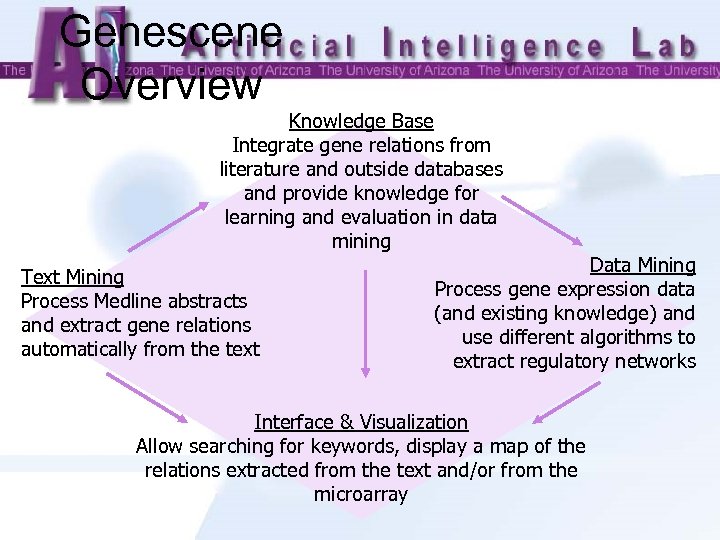
Genescene Overview Knowledge Base Integrate gene relations from literature and outside databases and provide knowledge for learning and evaluation in data mining Text Mining Process Medline abstracts and extract gene relations automatically from the text Data Mining Process gene expression data (and existing knowledge) and use different algorithms to extract regulatory networks Interface & Visualization Allow searching for keywords, display a map of the relations extracted from the text and/or from the microarray

JIF Ontologies External Databases HUGO Publications Medline XML Parser Publications & GO Meta Information UMLS Knowledge Base Titles & Abstracts Gene. Scene Text Mart Relation Parsers AZ Noun Phraser Lexical lookup UMLS POS Tagging Adjuster & Tagger Full Parser FSA Relation Grammar Relations in flat files Concept Space Relations in flat files Co-occurrence relations Feature Structures Gene. Scene Data Mart Text Mining Gene. Scene Information Retrieval Visualization Data Mining Spring Algorithm Micro Array Data Bayesian Networks Association Rule Mining

Problem (PBG) • Title Key roles for E 2 F 1 in signaling p 53 dependent apoptosis and in cell division within developing tumors. • Abstract: Apoptosis induced by the p 53 tumor suppressor can attenuate cancer growth in preclinical animal models. Inactivation of the p. Rb proteins in mouse brain epithelium by the T 121 oncogene induces aberrant proliferation and p 53 -dependent apoptosis. p 53 inactivation causes aggressive tumor growth due to an 85% reduction in apoptosis. Here, we show that E 2 F 1 signals p 53 -dependent apoptosis since E 2 F 1 deficiency causes an 80% apoptosis reduction. E 2 F 1 acts upstream of p 53 since transcriptional activation of p 53 target genes is also impaired. Yet, E 2 F 1 deficiency does not accelerate tumor growth. Unlike normal cells, tumor cell proliferation is impaired without E 2 F 1, counterbalancing the effect of apoptosis reduction. These studies may explain the apparent paradox that E 2 F 1 can act as both an oncogene and a tumor suppressor in experimental systems Expert errs and corrects Final graph

Example: Combination Inactivation of the p. Rb proteins in mouse brain epithelium by the T 121 oncogene induces aberrant proliferation and p 53 -dependent apoptosis Agent Of-template: By-template: Combo: Action null inactivate T 121 oncogene Theme p. Rb proteins null inactivate p. Rb proteins
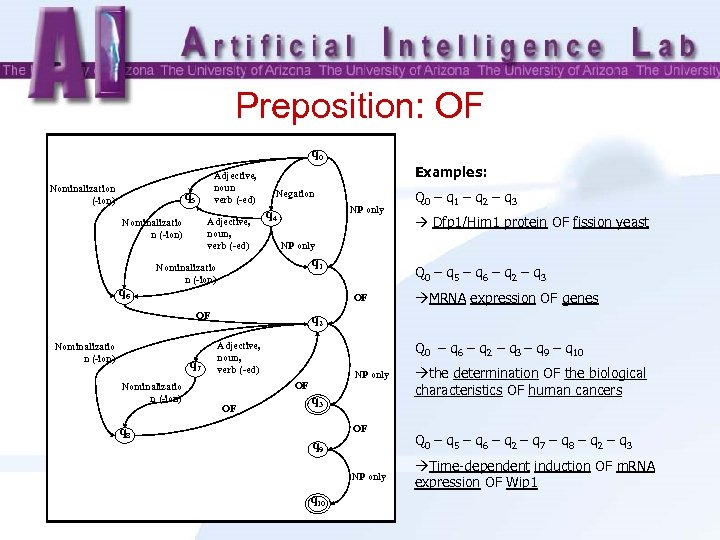
Preposition: OF q 0 Nominalization (-ion) Adjective, noun verb (-ed) q 5 Adjective, noun, verb (-ed) Nominalizatio n (-ion) q 6 Examples: Negation NP only q 4 q 1 OF Nominalizatio n (-ion) q 8 Q 0 – q 5 – q 6 – q 2 – q 3 OF q 7 Dfp 1/Him 1 protein OF fission yeast NP only Nominalizatio n (-ion) Q 0 – q 1 – q 2 – q 3 MRNA expression OF genes q 2 Q 0 – q 6 – q 2 – q 3 – q 9 – q 10 Adjective, noun, verb (-ed) NP only OF OF q 3 OF q 9 NP only q 10 the determination OF the biological characteristics OF human cancers Q 0 – q 5 – q 6 – q 2 – q 7 – q 8 – q 2 – q 3 Time-dependent induction OF m. RNA expression OF Wip 1

Visualization
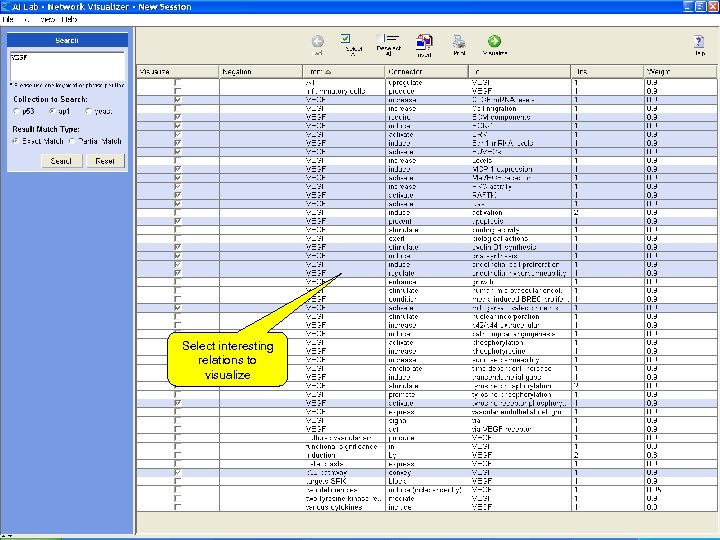
Select interesting relations to visualize
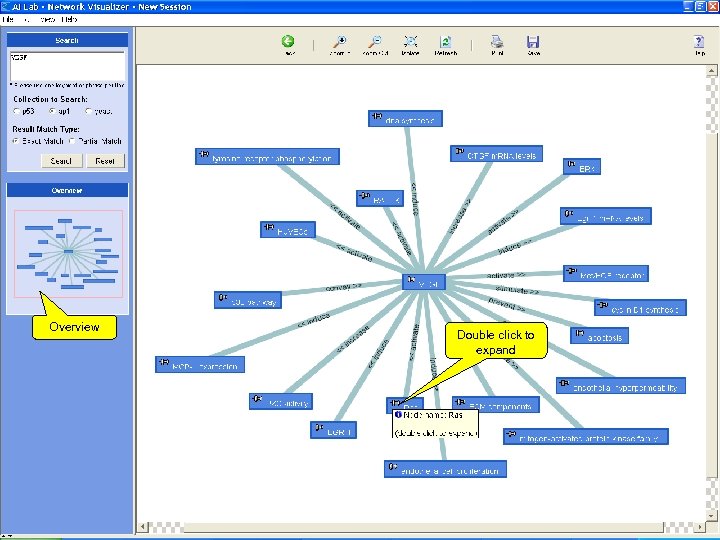
Overview Double click to expand
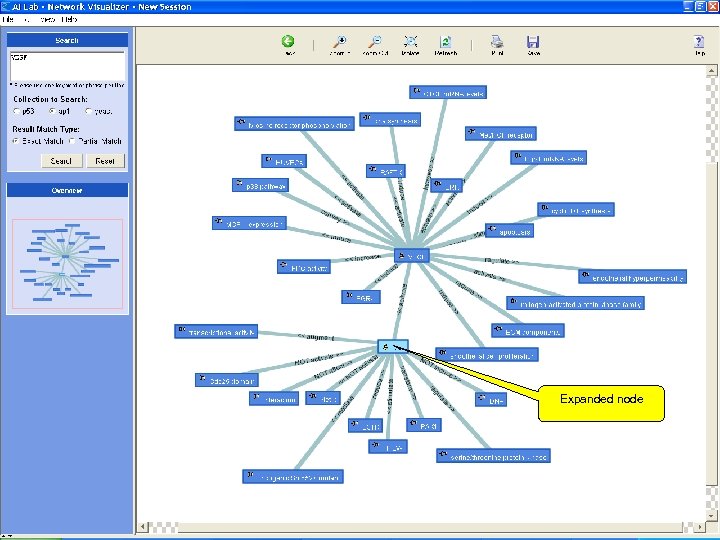
Expanded node
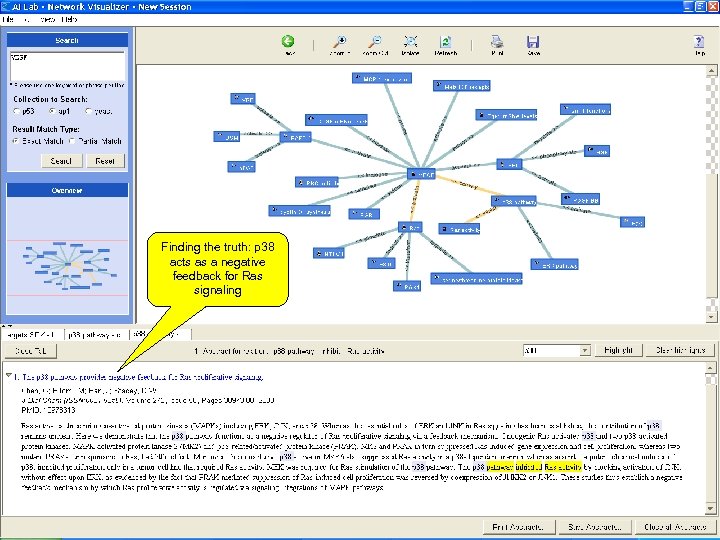
Finding the truth: p 38 acts as a negative feedback for Ras signaling
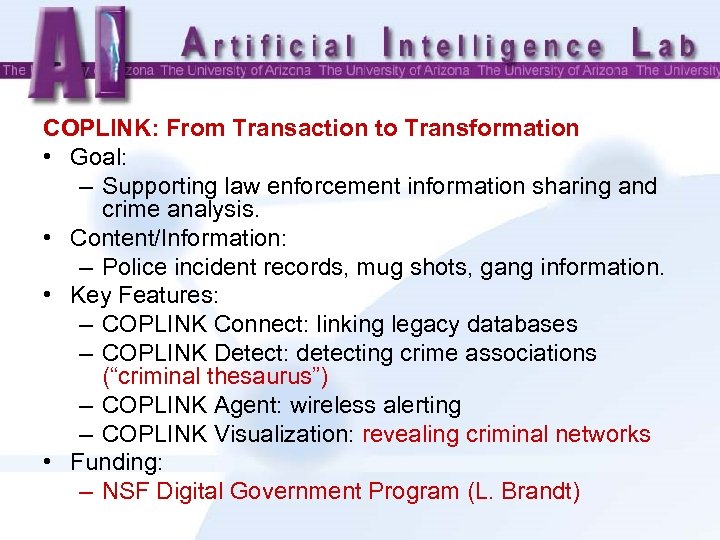
COPLINK: From Transaction to Transformation • Goal: – Supporting law enforcement information sharing and crime analysis. • Content/Information: – Police incident records, mug shots, gang information. • Key Features: – COPLINK Connect: linking legacy databases – COPLINK Detect: detecting crime associations (“criminal thesaurus”) – COPLINK Agent: wireless alerting – COPLINK Visualization: revealing criminal networks • Funding: – NSF Digital Government Program (L. Brandt)

Finding criminals: English and Chinese interface
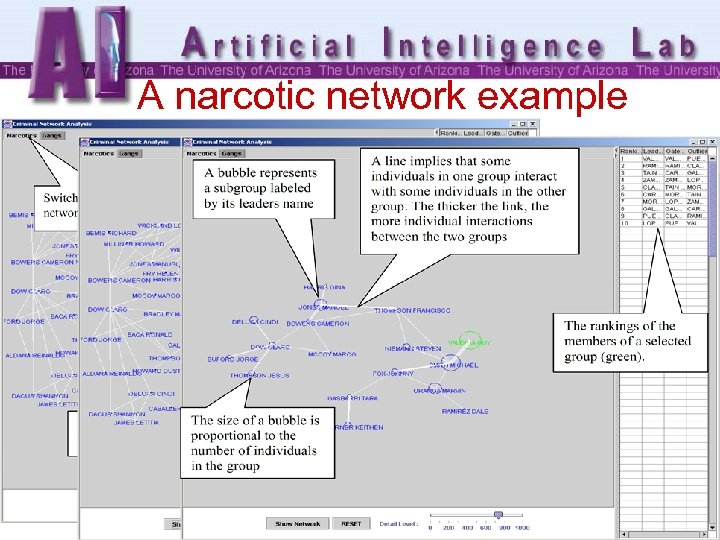
A narcotic network example

A gang network example
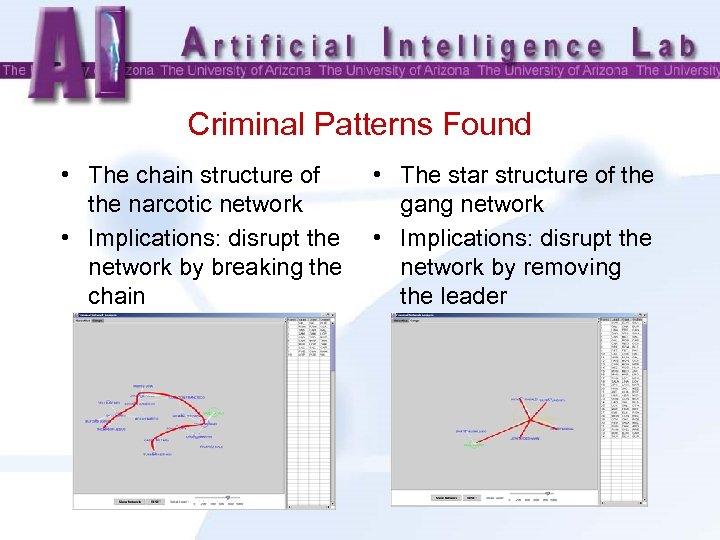
Criminal Patterns Found • The chain structure of the narcotic network • Implications: disrupt the network by breaking the chain • The star structure of the gang network • Implications: disrupt the network by removing the leader
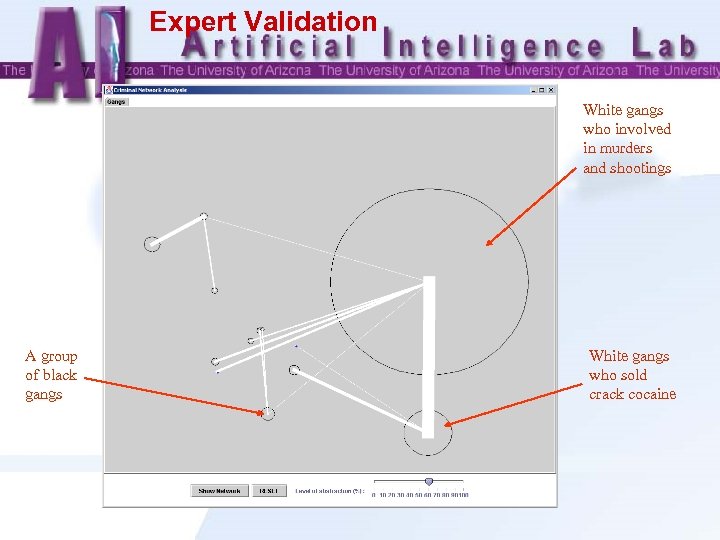
Expert Validation White gangs who involved in murders and shootings A group of black gangs White gangs who sold crack cocaine

Expert Validation “(211) and (173) are best friends” “Yes, these two groups are together very often”
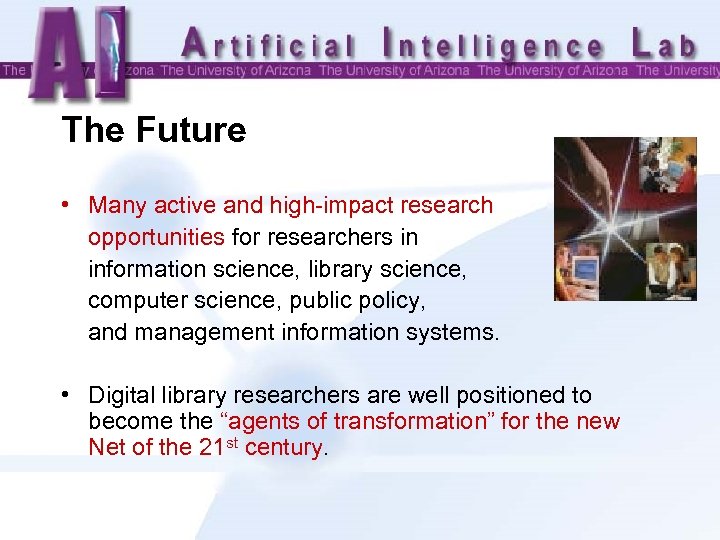
The Future • Many active and high-impact research opportunities for researchers in information science, library science, computer science, public policy, and management information systems. • Digital library researchers are well positioned to become the “agents of transformation” for the new Net of the 21 st century.

The Questions • Who/what is a “librarian”? • How to transform data and information into knowledge? • How to balance between technology, policy, users, and services?

For more information • “Knowledge Management Systems, ” H. Chen, 2002 • “Trailblazing a Path Towards Knowledge and Transformation, ” H. Chen, 2003 • International Conference of Asian Digital Libraries, December 8 -11, 2003, KL, Malaysia • ACM/IEEE Joint Conference on Digital Libraries, June 7 -11, 2004, Tucson, Arizona • NSF International Digital Library Workshop, June 10 -11, 2004, Tucson, Arizona (successful national DL projects)

For Project Information at AI Lab: http: //ai. bpa. arizona. edu hchen@bpa. arizona. edu
255b9726316ba1058dd39768bb59af44.ppt